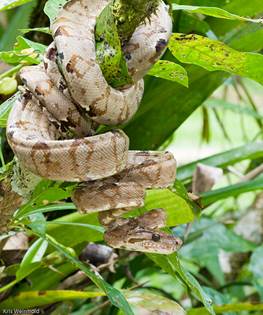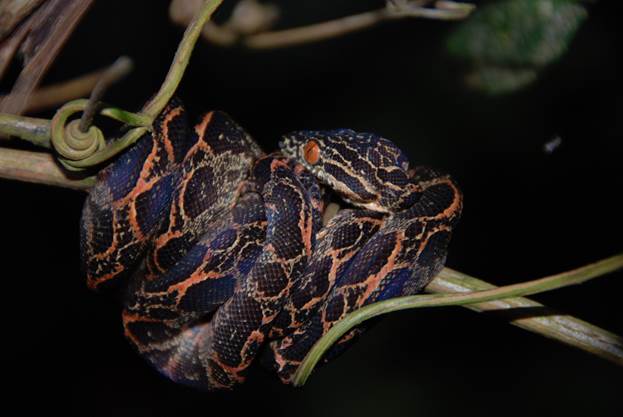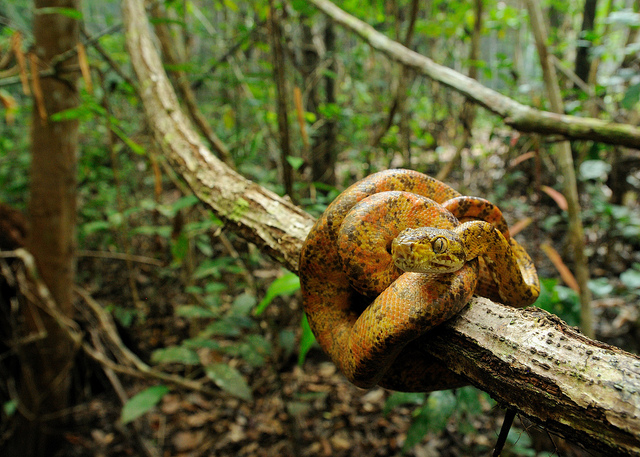Deep down inside me a tiny voice was calling. At first scarcely audible, it persisted until I could no longer ignore it. It was the voice of the wild places, and I knew that it was now part of me forever. –Percy Fawcett, Amazon explorer.
This is a relatively common species found in the Amazon basin east of the Andes including southern Venezuela, Guyana, Suriname, French Guiana, Bolivia, Peru, Ecuador, and Amazonian Brazil. They are found at lower elevations, typically below 1,000 ft. Corallus hortulanus has been reported from rain forests, banana plantations, mangroves, and fruit orchards.
These are a moderate sized snake that grows to about 6.5 feet in length. These boas display a wide range of colors from black, brown, gray, red, orange, yellow or something in-between. Many show distinct dark bands, speckles or chevron shapes while others have no patterns. They are lumped into two color “phases” – ‘garden phase” refers to those with more drab browns and olive colors while the “colored phase” ones have red, orange, and yellow base colors.
While a bit on the slender side, these snakes have a reputation for being aggressive. They have narrow, needle-like teeth that make for a painful encounter. But they usually give some type of warning before striking and will give more of a low level love-bite, unless a full-on assault is necessary to deter a predator. While travelling in the Amazon I heard about these common snakes – they are good climbers and may often be encountered on low-hanging tree branches, thus, surprising the unwary traveler brushing a limb out of their way on a trail.
They are ambush hunters and will just hang out on a limb at night, waiting for a prey item to wander by –detecting infrared heat using their sensory pits. They can strike a prey item at a “surprising distance” from their s-curve stance.

They will feed on a variety of small mammals, frogs, birds, and small reptiles. They are known to live up to 20 years in captivity but their typical longevity in the wild is unknown. Amazon tree boas are a constrictor – they will bite a prey and quickly wrap it in its coils, slowly suffocating the prey and then eating it whole.
Both males and females have anal spurs that protrude on their bodies on either side of the cloacal opening – males have larger spurs than females. The males appear to use their spurs to caress the female during courting. Females give live birth to the young 6-8 months following breeding with up to 14 young. Because they are such good climbers these boas will spend their entire life off of the forest floor – feeding, mating, and giving birth – all in the canopy of trees and shrubs.
They are a popular snake for the pet trade and in 2002 about 3,000 were exported from Guiana. This snake has no special U.S. federal status or under the Convention on International Trade in Endangered Species (CITES).
I spent a couple months in Bolivia, mostly in the mountains but had a week in the Amazon. While there we went on a couple evening critter searches, including one on the adjacent oxbow lake, slowly moving around the perimeter and searching with headlamps. Our guide pointed out a whole host of spiders and tree frogs and then pointed me to the tree boa. Where? I asked several times – I sure as heck couldn’t find it.

We got closer and closer to the edge of the vegetation with me still unable to find the snake, when the guide leaned out and pulled on a branch so the end of it arced in my direction, stopping one foot from my face. OH! There it is. Connie held the branch and I took a few photos and we then let him go back to his business.
Our guide had spotted the tiny, glowing eyes at about 50 feet away. I couldn’t find the dang thing until it was close enough to bite my nose.
